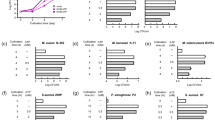Abstract
Macrophages, upon phagocytosing endospores of Bacillus anthracis, up-regulate the expression of the immunological isoform of nitric oxide synthase, NOS 2, concomitant with production of nitric oxide (NO•) from metabolism of l-arginine. We have previously demonstrated that macrophages that secrete NO• kill the bacilli of B. anthracis. To circumvent this microbicidal activity of NO•, B. anthracis has evolved pathways that include the enzyme arginase, which metabolizes l-arginine to ornithine and urea. Compounds that inhibit arginase might, therefore, offer a therapeutic approach to controlling B. anthracis infection. 2(S)-Amino-6-boronohexanoic acid (ABH) has been reported to be an inhibitor of mammalian arginase. In this study, we explore the inhibitory effect of ABH against B. anthracis arginase and its potential for future development, as an effective therapeutic agent against microbial infection. We found that ABH is an inhibitor of bacterial arginase in several different endospore strains of B. anthracis. Further, ABH inhibits neither the phagocytosis of these endospores nor the up-regulation of NOS 2 concomitant with secretion of NO•. These findings set the stage to determine how efficacious ABH will be in promoting NO•-mediating killing of B. anthracis.






Similar content being viewed by others
References
Baillie L, Hibbs S, Tsai P et al (2005) Role of superoxide in the germination of Bacillus anthracis endospores. FEM Microbiol Lett 245:33–38
Bergman NH, Passalacqua KD, Gaspard R, Shetron-Rama LM, Quackenbush J, Hanna PC (2005) Murine macrophage transcriptional responses to Bacillus anthracis infection and intoxication. Infect Immun 73:1069–1080
Bivalacqua TJ, Burnett AL, Hellstrom WJG et al (2007) Overexpression of arginase in the aged mouse penis impairs erectile function and decreases eNOS activity: influence of in vivo gene therapy and anti-arginase. Am J Physiol 292:H1340–H1351
Das P, Lahiri A, Lahiri A, Chakravortty D (2010) Modulation of the arginase pathway in the context of microbial pathogenesis: a metabolic enzyme moonlighting as an immune modulator. PLoS Pathog 6:e1000899
El Kasmi KC, Qualls JE, Pesce JT et al (2008) Toll-like receptor-induced arginase 1 in macrophages thwarts effective immunity against intracellular pathogens. Nat Immunol 9:1399–1406
Gobert AP, McGee DJ, Akhtar M et al (2001) Helicobacter pylori arginase inhibits nitric oxide production by eukaryotic cells: a strategy for bacterial survival. Proc Natl Acad Sci USA 98:13844–13849
Lahiri A, Das P, Chakravortty D (2008) Arginase modulates Salmonella induced nitric oxide production in RAW264.7 macrophages and is required for Salmonella pathogenesis in mice model of infection. Microbes Infect 10:1166–1174
Lewis ND, Asim M, Barry DP et al (2010) Arginase II restricts host defense to Helicobacter pylori by attenuating inducible nitric oxide synthase translation in macrophages. J Immunol 184:2572–2582
Porasuphatana S, Cao GL, Tsai P et al (2010) Bacillus anthracis endospores regulate ornithine decarboxylase and inducible nitric oxide synthase through ERK1/2 and p38 mitogen-activated protein kinase. Curr Microbiol 61:567–573
Raines KW, Kang TJ, Hibbs S et al (2006) Importance of nitric oxide synthase in the control of infection by Bacillus anthracis. Infect Immun 74:2268–2276
Schimke RT (1970) Arginase (rat liver). Methods Enzymol 17:313–317
Smith H, Keppie J (1954) Observations on experimental anthrax: demonstration of a specific lethal factor produced in vivo by Bacillus anthracis. Nature 173:869–870
Soru E (1983) Chemical and immunological properties of B. anthracis arginase and its metabolic involvement. Mol Cell Biochem 50:173–183
Tsai P, Cao GL, Merkel TD, Rosen GM (2008) Spin labeling of Bacillus anthracis endospores: a model for in vivo tacking by EPR imaging. Free Radic Res 42:49–56
Viator RJ, Rest RF, Hildebrandt E, McGee DJ (2008) Characterization of Bacillus anthracis arginase: effects of pH, temperature, and cell viability on metal preferences. BMC Biochem 9:15
Weaver J, Kang TJ, Raines KW et al (2007) Protective role of Bacillus anthracis exosporium in macrophage-mediated killing by nitric oxide. Infect Immun 75:3894–3901
Weiner M, Hanna PC (2003) Macrophage-mediate germination of Bacillus anthracis endospores requires the gerH operon. Infect Immun 71:3954–3959
Weiner M, Read TD, Hanna PC (2003) Identification and characterization of the gerH operon of Bacillus anthracis endospores: a differential role for purine nucleosides in germination. J Bacteriol 185:1462–1464
Acknowledgment
This research was supported in part by a Grant from the Maryland Industrial Partnership and Corridor Pharmaceuticals, Inc.
Author information
Authors and Affiliations
Corresponding author
Rights and permissions
About this article
Cite this article
Tsai, P., Cao, GL., Tomczuk, B. et al. Effect of the Mammalian Arginase Inhibitor 2(S)-Amino-6-Boronohexanoic Acid on Bacillus anthracis Arginase. Curr Microbiol 64, 379–384 (2012). https://doi.org/10.1007/s00284-012-0084-9
Received:
Accepted:
Published:
Issue Date:
DOI: https://doi.org/10.1007/s00284-012-0084-9




